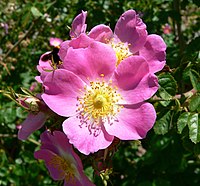
Photo from wikipedia
Rosa x damascena Mill. essential oil is mainly used in the cosmetics and perfumery industry, but it also finds application in the food industry as a flavoring agent. The chemical… Click to show full abstract
Rosa x damascena Mill. essential oil is mainly used in the cosmetics and perfumery industry, but it also finds application in the food industry as a flavoring agent. The chemical composition of essential oils is affected by environment, soil, harvesting technique, storage condition, and extraction methods. Nowadays, the study and design of greener, more efficient, and sustainable extractive procedures is the main and strategic focus in the chemical research and development of botanical derivatives, especially as regards fragrances and essential oils. Several technologies are available, and the best method to use depends on the desired chemicals, but conventional extractive processes are often laborious and time-consuming, involve large amounts of solvents, and may cause the partial loss of volatiles, affecting the quality of the final product. In the last decade, microwave irradiation has been successfully applied to classical techniques, often improving the general extractive efficiency and extract quality. In the present paper, as a preliminary analytical screening approach, two microwave-mediated techniques, Solvent-Free Microwave Extraction (SFME) and Microwave Hydrodiffusion and Gravity (MHG), and two conventional procedures, Hydrodistillation (HD) and Steam Distillation (SD), were applied and compared for the extraction of volatile compounds from R. x damascena fresh petals to highlight differences and advantages of the selected procedure and of the obtained extracts useful in a cosmetic context as fragrances or active ingredients. The chemical composition of the extracts was investigated by GC-MS and GC-FID. Sixty-one components, distributed in the four techniques, were identified. SD and HD are dominated by oxygenated terpenes (59.01% and 50.06%, respectively), while MHG and SFME extracts are dominated by alcohols (61.67% and 46.81%, respectively). A relevant variability in the composition of the extracts relating to the extraction techniques used was observed. To point out the correlation between the process and composition of the obtained natural products, principal component analysis (PCA) of the data extracted from GC-FID was used. Taking into account a cosmetic application, SFME shows several advantages when compared with the other procedures. The extract (obtained in a significantly higher amount) contains a meaningful lower level of potential fragrance allergenic compounds and quite a double amount of benzyl alcohol and 2-phenyl ethanol that can also enhance the preservative action in personal care products.
Journal Title: Molecules
Year Published: 2022
Link to full text (if available)
Share on Social Media: Sign Up to like & get
recommendations!